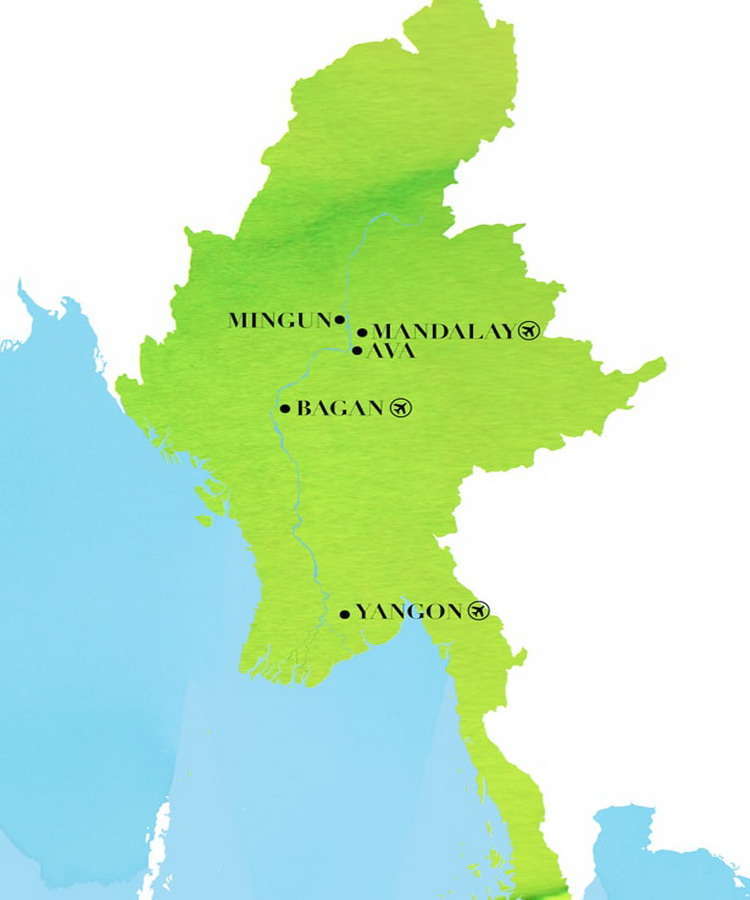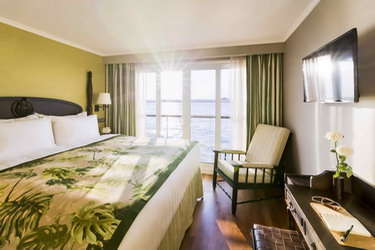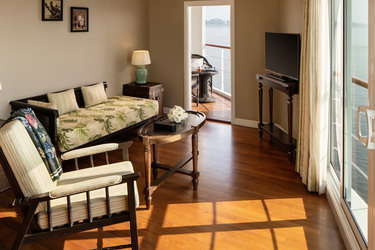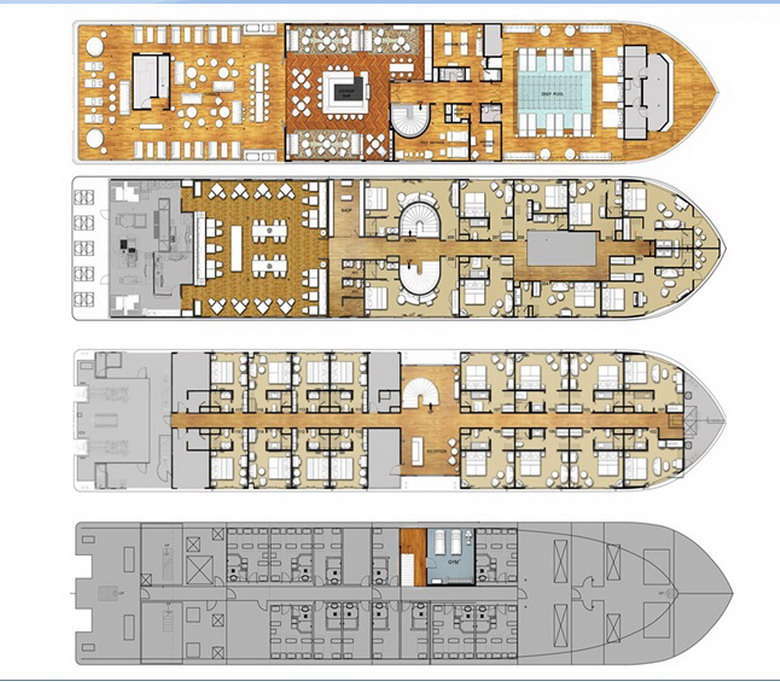from 0 review
The Strand Cruise was custom built in 2015 in a shipyard in Yangon with a shallow 1.4m draft, designed to successfully navigate the shallow rivers of Myanmar. The 61m ship carries up to 50 passengers in 25 cabins along the mystical waterways of the Ayeyarwady River. Named and styled after its sister property, the luxury heritage hotel, The Strand Yangon, The Strand Cruise offers all the features passengers would expect from a Strand product, from flawless service and gourmet a la carte cuisine, to signature elements celebrating the golden age of the Strand as a meeting place for explorers and raconteurs.
The Strand Yangon was one of the first luxury colonial outposts to open in South East Asia, founded in 1901 by famous hoteliers, the Sarkies brothers, and remains one of the most architecturally beautiful landmarks in the region. In 2016, The Strand Yangon entered a new era as it reopened after a six-month restoration project that saw the iconic hotel ushered elegantly into the 21st century. The renovation project preserved the heritage at the heart of the hotel and honoured the Strand’s part in Myanmar’s history whilst creating a more relaxed, refined and glamorous setting for 21st century travellers.

The Strand’s two-night cruise from Mandalay to Bagan begins with a welcome breakfast at U-Bein Bridge then visit to the Mahamuni Pagoda. After enjoying lunch aboard, we sail to Mingun, one of the country’s former capitals, visiting the unfinished pagoda, as well as the Hsinbyume Pagoda and Mingun bell.
Day two sees our passengers to Ava, one of Myanmar’s ancient imperial capitals, for a delightful ride through the naturally preserved landscape and key landmarks. Here we visit the Yadana Shemee. Once back on board, the ship cruises onwards throughout the afternoon towards the ancient city of Bagan.
After a healthy breakfast onboard disembark in Bagan where guests will then be accompanied to the airport or their hotel in Bagan.

The Strand’s three-night cruise from Mandalay to Bagan begins with a welcome breakfast at U-Bein Bridge then visit to the Mahamuni Pagoda. After enjoying lunch aboard, we sail to Mingun, one of the country’s former capitals, visiting the unfinished pagoda, as well as the Hsinbyume Pagoda and Mingun bell.
Day two sees our passengers to Ava, one of Myanmar’s ancient imperial capitals, for a delightful Horse cart ride through the naturally preserved landscape and key landmarks. Here we visit the Yadana Shemee. Once back on board, the ship cruises onwards throughout the afternoon towards the ancient city of Bagan.
Day three is spent exploring Bagan’s wonders, including the Ananda Temple, one of the most exquisite temples of the country; the Shwezigon Pagoda, renowned for its gold leaf décor; the beautiful Sulamani temple and Gubyaukgyi temple; before rejoining your fellow guests for a farewell dinner full of gastronomic delight.

The Strand’s four-night cruise from Bagan to Mandalay begins with breakfast in the tranquil gardens of the oldest lacquerware house in Bagan, before passengers visit the nearby Shwezigon Pagoda, famous for its gold leaf décor, and the Ananda temple, one of most exquisite temples in Myanmar. After enjoying lunch on board, passengers continue their exploration of the Bagan Heritage Trail, including the beautiful Sulamani and Gubyaukgyi temples.
The ship casts off on day two for a relaxing cruise upstream towards Mandalay to enjoy the passing landscapes and villages along the river bank, with scenes reminiscent of the days of Rudyard Kipling and other intrepid explorers who have visited this rugged landscape over the centuries.
After a leisurely breakfast, day three brings a visit to Ava, the ancient imperial capital of successive Burmese Kingdoms from the 14th to 19th centuries. Horse carts await the ship to transport guests for a delightful ride through the naturally preserved Ava landscape and key landmarks.
Day four sees The Strand Cruise arrive in Mandalay, Myanmar’s second- largest city and the last royal capital of Myanmar. Our passengers first stop is the U-Bein Bridge, a crossing that spans the Taungthaman Lake near Amarapura before visiting the Mahamui Buddha temple. Following lunch back on board as we cruise, the ship stops in Mingun, one of the country’s former capitals. Guests will visit the unfinished pagoda, as well as the Hsinbyume pagoda and Mingun bell. Our final night is spent at an exclusive mooring overnight close to a temple in Ava, while guests say farewell to their fellow passengers with a gastronomic dinner.
Important note*
| Cabintype | Rates (US$/person) |

|
Contact us for price |

|
|

|
|

|
Accommodation; daily (group) shore-excursions & entrance fees; sightseeing and transfers during the cruise; transfers from/to Heritage Line’s meeting point to/from the ship (please read details in the embarkation guide); English speaking tour guiding on-and offshore; entertainment/activities during the cruise as mentioned in the program; meals as mentioned in the program; welcome drink, brewed coffee, tea and mineral water; passenger liability insurance; internet on the ship (subject to cellular network signal); complimentary usage of ship facilities (exclusive of spa treatments); port or anchorage fees; river pilots; fuel.
Crew and guide gratuities; visa fees; private transfers; personal expenses; beverages other than those stated under inclusions; medical services; spa treatments; port and anchorage fees; all other services or items not listed under inclusions.
Cancellation by Customer
For cancellations of bookings, the following charges will apply:

The rivers you will sail on are subject to seasonal rises and falls of water level, in some places as much as 30 metres. Water levels can change dramatically overnight and a sudden rise can impede our progress upstream considerably and even prevent us from passing under certain bridges. A sudden fall can result in our being unable to get into certain places or go as far upstream as we would hope. Groundings on sandbars are not infrequent and are part of the
excitement of any expedition. Published itineraries are indicational only and subject to sudden change. In such events alternative itineraries will be provided and we do our best to ensure that if a stop is missed we make up for it with another stop.
Passengers are thus forewarned and expected to be flexible and patient. River cruising in Asia can be a dramatic and adventurous experience – not like cruising the controlled waterways of Europe or America. Note also that we operate in areas with little or no developed infrastructure and subject to the strictures of local officialdom. Be prepared for this and it is all more the fun!
For itineraries that include flights in the price of the ticket it should be noted that regional airlines can change departure times or cancel flights at very short notice. In such an event we endeavour to arrange alternative flights but note that this can result in delays often resulting in embarking or disembarking on a different day to that indicated in the itinerary. In such an event the company will cover the cost of hotel accommodation and main meals only, but will not be liable for any claims for compensation for missed days on board a ship, drinks or curtailment of the said itinerary.
We recommend wearing loose and comfortable clothing made of cotton or modern material that can readily cool off sweat and body hear. The type of shoes will depend on the excursion types so best to have both light, open toed shoes as well as good walking/hiking shoes with you. A sun hat is always a good idea to bring along.
Southern Vietnam and Cambodia are warm all year-round, but our other cruise destinations can get chilly during the winter months (Laos, Myanmar or northern Vietnam). Therefore, it is always recommended to bring a pullover or a warm jacket with you during this period.
Many of our cruises include visits to local temples or pagodas. When visiting these holy sites, make sure to wear appropriate clothing which covers your shoulders and knees.
Generally speaking, the rivers we are cruising on in Southeast Asia are very calm and there is hardly any motion on any of our ships. A bit of motion can occur during monsoon rains with stormy winds, but the amount of motion is much less than one would feel during bad weather on the open ocean.
Sea cruises as we offer in Halong Bay or Lan Ha Bay can sometimes encounter heavier waters and ship motion, although this happens very rarely and port authorities will most likely not allow sailing under any such circumstances anyway.
If you are new to cruising or prone to motion sickness, it does not hurt to bring along some motion sickness medication. Drinking a nice hot fresh ginger tea is a natural remedy and tasty alternative our staff is always happy to make for you.
All food and beverage on board is completely safe to eat and enjoy, including the ice cubes you enjoy in your chilled drinks. We do not recommend drinking water straight from the tap anywhere, including onboard. We provide you with complimentary clean drinking water throughout your cruise.
You may want to be bit careful with local dishes as they can be spicier than you are used to from home. Approach new dishes slowly and carefully. If you have a sensitive stomach, then you may like to double check with our chef or onboard managers about specific dishes or meals.
On excursions, it may be a good idea to avoid local foods and snacks unless offered by our tour guides. Besides the above, in general we recommend the following motto for your pre- and post-cruise travelling in the Southeast Asian tropics: boil it, peel it, cook it, wash it or forget it!
The most effective protection from personal contamination is ensuring strict attention to personal hygiene and in particular, frequent and thorough hand washing with soap and water and refraining from hand-to-mouth contact. Colds and other viruses can spread quickly in an enclosed area such as a ship. Continue to practice common-sense hygiene and respiratory courtesy. Wash your hands often and cover your coughs and sneeze. It is recommended that passengers carry anti-bacterial hand sanitizer, which does not require rinsing with water. Use sanitizer frequently and throughout the day, particularly after shore excursions and prior to meals. If you have any questions regarding your health or safety, please do not hesitate to ask your cruise director.
Motion sickness can be a problem for some people when cruising, flying or travelling on coaches and trains and it is a good idea to take precautionary measures. Over-the-counter drugs for treating motion sickness can be purchased at pharmacies in most countries, though a side effect can by drowsiness. Alternatives such as ginger tablets and acupressure wristbands are also available and work well for some people.
Cambodia visas are easily obtained for most travelers on arrival. Note that passports must have a validity of at least 6 months after your last date of travel in Cambodia.
Because travel restrictions across Southeast Asia are constantly changing, we recommend checking with the Cambodia embassy/consulate in your home country for the latest information.
With the exception of visa exemptions, all travelers must arrange their visa prior to arrival in Vietnam. Passports must also have a validity of at least 6 months after your last date of travel in Vietnam.
Because travel restrictions across Southeast Asia are constantly changing, we recommend checking with the Vietnam embassy/consulate in your home country for the latest information.
We recommend at least purchasing travel health insurance which covers both in- & outpatient visits and medical repatriation. Buying additional trip cancellation and interruption coverage may also be beneficial in case you have to cancel your travel plans due to unforeseen circumstances.
We always recommend bringing a travel adapter as a standard item in your travel kit. You can borrow an adapter on board, but these may be limited.
Leave a reply